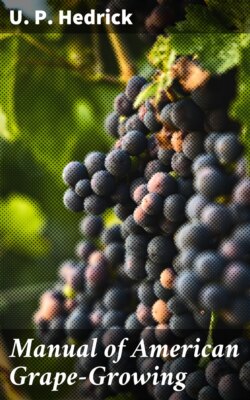Читать книгу Manual of American Grape-Growing - U. P. Hedrick - Страница 61
На сайте Литреса книга снята с продажи.
Vineyard grafting on the Pacific slope.
ОглавлениеVineyard grafting, according to Bioletti,[3] was formerly the commonest method of starting resistant vineyards in California. After stating that it is best whenever possible to plant good cuttings rather than roots, and that the grafting should usually be done the year after planting, Bioletti gives the following directions for grafting:[4]
"Wherever possible the vines should be grafted at or above the surface of the ground. In many cases, however, it will be necessary to go below the surface to find a smooth, suitable part of the stock where grafting is possible.
"The kind of graft to use will depend on the size of the stock. For stocks up to 2/3 inch in diameter the methods of tongue and wire grafting already described are the best. For larger vines up to 3/4 inch a modification of the ordinary tongue graft is the best. If the tongue graft were made in the usual way with stocks of this size, it would be necessary to use excessively large scions, which is undesirable, or to have the barks unite only on one side. By cutting the bevel of the stock only part way through the vines, it is possible to make a smaller scion unite on both sides. For still larger vines, those over 3/4 inch in diameter, the best graft is the ordinary cleft.
"No wax or clay should be used on the graft. Anything which completely excludes the air prevents the knitting of the tissues. A little clay, cloth, or a leaf may be placed over the split in the stock when the cleft graft is used, simply to keep out the soil. Otherwise there is nothing more suitable or more favorable to the formation of a good union that can be put around the graft than loose, moist soil. If the soil is clayey, stiff or lumpy, it is necessary to surround the union with loose soil or sand brought from outside the vineyard.
"It will usually be necessary to tie the grafts. A well-made cleft graft often holds the scion with sufficient force to prevent its displacement and no tying is necessary. Wherever there is any danger of the graft moving, however, it should be tied. There is nothing better for this purpose than ordinary raffia. The raffia should not be bluestoned, as it will last long enough without and will be sure to rot in a few weeks, and the trouble of cutting it will be avoided. Cotton string or anything which will keep the graft in place for a few weeks may also be used.
"As soon as the graft is made and tied, a stake should be driven and the union covered with a little earth. The hilling up of the graft may be left for a few hours, except in very hot, dry weather. Finally, the whole graft should be covered with a broad hill of loose soil 2 inches above the top of the scion.
"Field grafting should not be commenced as a rule, except in the hottest and driest localities, before the middle of March. Before that there is too much danger that heavy rains may keep the soil soaked for several weeks—a condition very unfavorable to the formation of good unions. In any case the grafting should not be done while the soil is wet. Grafting may continue as long as the cuttings can be kept dormant. It is difficult to graft successfully, however, when the bark of the stock becomes loose, as it does soon after the middle of April in most localities."
As in the East, it is necessary in California to remove suckers from the roots and roots from the cions once or twice during the summer. Suckers should not be allowed to overshade the graft, though it is best not to remove them until danger of disturbing the graft is past. The grafts should be staked and the vines looked after as recommended for eastern conditions.
Plate III.—Cover-crops. Top, cow-horn turnips; bottom, rye.
